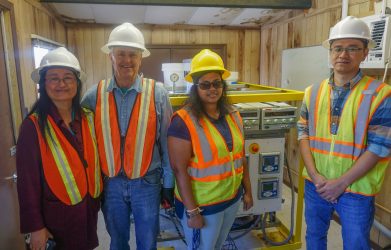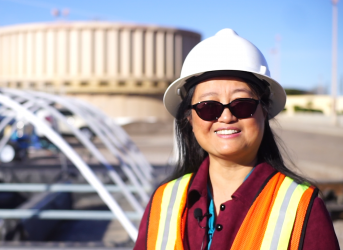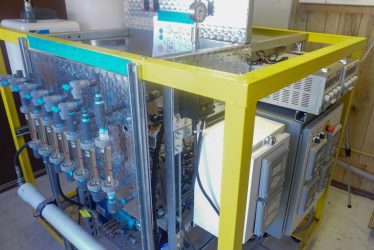DATE: 04/22/2019
WRITER: Linda Fresques, 575-646-7416, lfresque@nmsu.edu
CONTACT: Pei Xu, pxu@nmsu.edu
A team of New Mexico State University graduate students and Environmental Engineering professors Nirmala Khandan and Pei Xu are developing a novel water treatment process that could render municipal wastewater into drinking water and at the same time produce algal biomass for biofuel and fertilizer.
|

From left: NMSU Environmental Engineering Professor Pei Xu, Program Specialist David Johnson, Ph.D. student Chathurika Bandara and Postdoctoral Researcher Xuesong Xu are monitoring the treatment process they developed to render municipal wastewater into drinking water. NMSU Photo by Vladimir Avina
|
They have a pilot-scale research project at the Jacob A. Hands Wastewater Treatment Facility in Las Cruces to develop this technology. Using a method created by Khandan, wastewater goes into two 2,000-liter bioreactors that use algae to convert carbon, nitrogen and phosphorous into biological material that once water is removed, can be used for biofuel and also fertilizer.
The algal effluent flows into an NMSU pilot-scale research facility at the plant for a new treatment process that combines both forward and reverse osmosis to separate water from algal biomass.
“Forward osmosis is an emerging treatment technology that is unique because it does not use pressure to separate the algae from the water, as in reverse osmosis,” said Xu. Forward osmosis is a natural process that draws the water through a semipermeable membrane that removes contaminants.
“On one side of the membrane we have the algal effluent which has a low salinity. On the other side of the membrane we have salty water, which naturally draws the water through the membrane by osmotic pressure gradient,” explained Xu.
The water drawn through the membrane dilutes the salty water on the other side. That water is then treated by reverse osmosis, which uses pressure to push the water through the membrane, resulting in clean, potable water. The re-concentrated saline solution is returned to continue removing fresh water from the algal effluent.
“We use forward osmosis as a pretreatment because the membrane has a lower fouling potential, where organic matter, bacteria and algae are deposited on the surface of the membrane and degrade performance of the membrane,” said Xu.
The treated water is tested to ensure that it meets the drinking water standards stipulated by the state of New Mexico and U.S. Environmental Protection Agency. The purified water then can be distributed to drinking water system for direct potable water reuse, or injected into the ground for groundwater recharge and augmenting groundwater supplies. The city of Scottsdale and Orange County use reverse osmosis to treat wastewater and return it to the groundwater supply. El Paso is planning for direct potable reuse by putting treated wastewater directly into the drinking water supply, said Xu.
“The removal of algae from the wastewater is challenging,” said Xu. “In order to discharge this water into the river it needs to be water, not full of algae. So we recover the algae for biomass-biofuel production and also for fertilizer production.”
|

NMSU Environmental Engineering Professor Pei Xu is leading a pilot-scale research project at the Jacob A. Hands Wastewater Treatment Facility in Las Cruces to develop a treatment process for reuse of wastewater. NMSU Photo by Vladimir Avina
|
Ph.D. candidate Chathurika Bandara said, “Normally wastewater has to go through a lot of processes to achieve the discharge standard for drinking water. We are trying to achieve this with just one step. And we can harvest energy from the biomass—it’s a win-win scenario.” Bandara’s research focus is to ensure that the treated water meets regulatory standards.
The water is tested not only for EPA regulations for drinking water but also for contaminants of emerging concern, including pharmaceuticals, personal care products, hormones and pesticides, that are increasingly being detected at low levels in surface water.
Tanner Schaub, director of the Chemical Analysis and Instructional Laboratory in the College of Agricultural, Consumer and Environmental Sciences is collaborating with the team. The facility houses high-end instrumentation that can be used in a variety of research areas.
“We can give Dr. Xu’s team a very detailed picture of what was in the wastewater before and after treatment. We can tell what compounds were removed and if there were things that were resistant to the treatment. That informs the engineers how to tailor the process for better results,” said Schaub.
Initially, the group started with bench-scale testing in the laboratory funded by Engineering Research Center for Re-inventing the Nation’s Urban Water Infrastructure (ReNUWIt), led on the NMSU campus by Khandan. Later, Khandan and Xu received funding from the U.S. Bureau of Reclamation to move the project into pilot-scale treatment, which has a capacity of treating one gallon of effluent per minute.
|

A research facility at the Las Cruces wastewater plant houses a device that uses forward and reverse osmosis to remove water from wastewater treated with algae. The remaining biomass can be used for biofuel or fertilizer. NMSU Photo by Vladimir Avina
|
“This is just a demonstration of the technology,” Xu said. “It can have a very broad applications, but we are focusing on potable water use. It could be used in rural areas in small water systems if we can demonstrate the process has low-energy consumption and is low cost.”
Postdoctoral researcher Xuesong Xu and senior program specialist David Johnson are monitoring the treatment instrumentation’s performance through online sensors as electrical conductivity, temperature, pH levels, flowrates and pressure. They hope to use the data for system control and optimization. They also plan to make the process fully automated to reduce the labor cost for operating the system.
The next phase will be to continue this research at the Brackish Groundwater National Desalination Research Facility in Alamogordo to treat septic effluent. The goal is to demonstrate broad applications of the technology from municipal wastewater treatment to small systems in rural areas.
“The water shortage is a great challenge for the Southwestern United States and our research is focused on developing alternative water supplies,” said Xu.
Her group of three postdoctoral researchers, four Ph.D. candidates and three master’s students are also looking at ways to create clean water from produced water resulting from the oil and gas industry and brackish groundwater.

